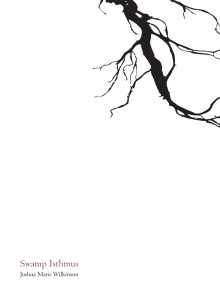Book Review

After every war
someone has to clean up . . .
Photogenic it’s not,
and takes years.
All the cameras have left
for another war.
—Wislawa Szymborska, “The End and the Beginning”
What is a republic without civil and linguistic subjects? Or, perhaps more to the point of Joshua Marie Wilkinson’s Swamp Isthmus, his sixth full-length collection, what is a country’s land (or occupied territories) if indebted, purchased on lien, or inhabited with blood in the (pay dirt) soil? The darker side of the economic and ecological history of America in the 20th century results in poems that mark time and space (on the land and the page) in a way that history has not, or has (but with documents that have been shredded, burned, or lost). Along with other poet-legislators such as Noelle Kocot, Juliana Spahr, and Claudia Rankine, who are tasked with the work of narrating history, naming traumas and enemy camps, and reconstructing, line by line, a sustainable (legible) future, Wilkinson is one of the foremost pioneers in documentary (and erasure) poetics, which scripts postmodern cartographic texts occupied with the burden and joy, post-war, of sifting through psychic curios and actual remains in search of lyric presence:
lumbering up
limberlost
to map in
lines of so-called
becoming.
Thoreau, Emerson, Hawthorne, Poe, and other narrators of America’s darker imagination (the anti-triumphalist legacy of genocide, imperialism and slavery), have been reinterpreted in more recent years in hauntologies such as Susan Howe’s, exploring the work of naming (and repossessing through language’s legal tender) one’s origins and land. However this exploration is made not through complete sentences, prose, or epiphanic sentiment, but by a poetics mimetic of what Wilkinson calls the “cordial disappearances” of nature, meaning, and mind.
The poems, in the form of unpunctuated, elliptical couplets, seethe with pathos: “a garish / fucked out light”; “shaking fits again”; “his music switches up / with a whipping.” They attempt spatial and semantic marking in lieu of the very “grid” that post-expressionist painters such as Mondrian or Agnes Martin perceived to undergird two-dimensional space. In contemporary politics, the bottom line is, of course, who owns the actual grids, whether of electrical power or cyber networks. Thus the terror of this collection is not so much living in fear of the plug being pulled, or the keystroke being pressed by the world’s ego-scripter (“thieves in the clearing / enlisting radios // as phones / as nets // so it works us / lung-like”), but that it already has been and we are living in the unnamed, unmarked detritus of post-space/time (amid what the poet calls “gravestones without number // numbers without name”). In a surveillance state, we are both monitored (“what you can’t hear / is what’s watching you“) as well as dependent upon the other to “write us” down (or hail us as subjects, according to Louis Athusser).
Musically, the effect of Wilkinson’s formal choices compels the reader to “hear” the caesurae of each line as unmarked on the page and confront the lines (metonymic of the lyric project itself) as isolated units of sense as well as in conversation with the other line in the couplet and the winding, paratactic logic of, not the sentence, but the poem (lacking terminal punctuation, and unimpeded by colons or dashes).
The beauty of this collection, formally and thematically, is the brio Wilkinson brings to the task of making sense out of and though form. He chooses to see the work of “scanning notes” (cryptography) and reconstruction (“rebuild[ing] the slashed meadows”) as an exploratory adventure of creation (“rhythms,” as the poets says, “are this way known”) rather than a malediction. Indeed, the physics of subject-subject or subject-object relations (reality as co-constituted instantaneously)—the moment when what Louise Glück calls “the perceived became the remembered, / the remembered, the perceived”— is at the heart of fiber optics, quantum physics, and the lyric. Here, Wilkinson’s rapprochement and penetration through language of the unspeakable boundary lines (the ultimate taboo or transgression) is what makes form possible:
what we are
forbidden from
startles the fence
closer
This poet couldn’t be more fit for the journey. Wilkinson has written extensively on, and in conversation with, visual art (Egon Schiele) and film. He is deeply conscious that poetic utterance was traditionally an intentioned act (lyric address purposed for an “other” as an act of fraternity, call and response, cri de coeur). His nods to John Keats and other invented and historic personae (Max Roach, Edgar Huntly) signal the act of communication, however broken or covert, as central to the journey away from the illimitable (and therefore unintelligible) chaos of an unlettered republic (“a hamlet of / unschooled truants”), unrestricted free market, and the formlessness (ironically) of post-conceptualism, back toward the welcomed bounds—and chosen bonds—of aesthetic form, meter, friendship, spatial geography, and finitude in time.
About the Reviewer
Virginia Konchan’s poems have appeared in Best New Poets, The Believer, The New Yorker, and The New Republic; her criticism in Workplace: A Journal for Academic Labor, Quarterly Conversation, New Madrid, and Boston Review; and her fiction in StoryQuarterly and Joyland, among other places. The recipient of grants and fellowships to Scuola Internazionale di Grafica, Ox-Bow, and Vermont Studio Center, Konchan is co-founder of Matter, a journal of poetry and political commentary.